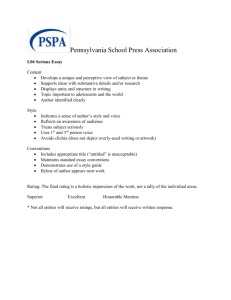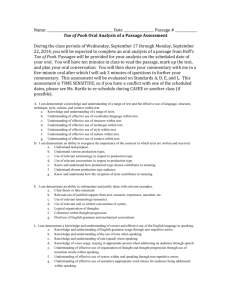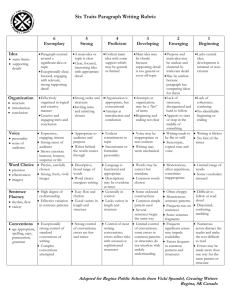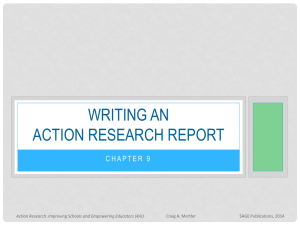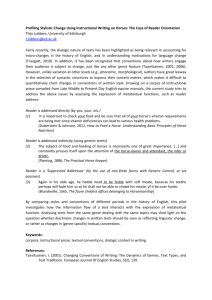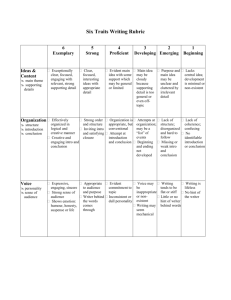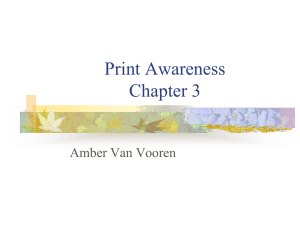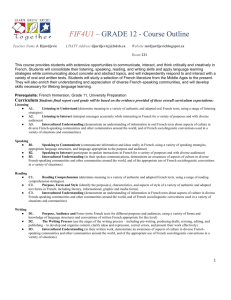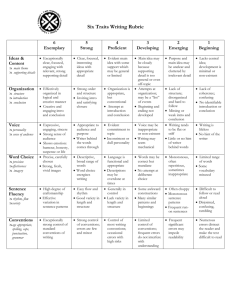Year 12 Program 2015
advertisement
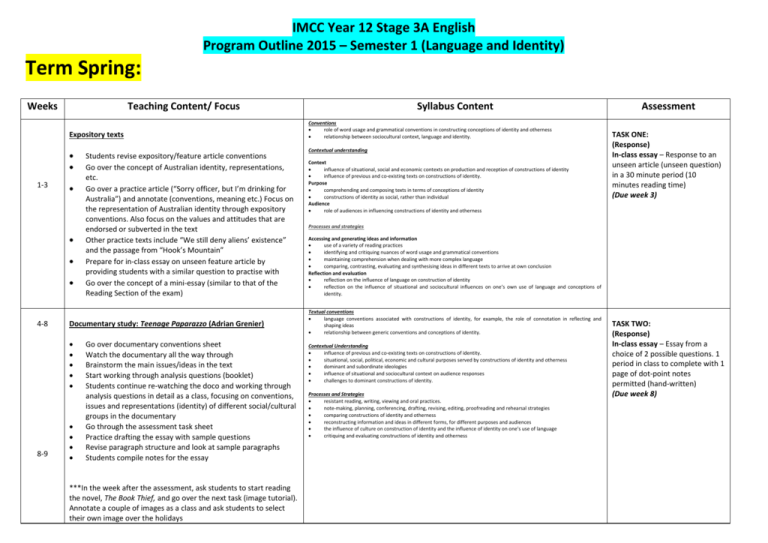
IMCC Year 12 Stage 3A English Program Outline 2015 – Semester 1 (Language and Identity) Term Spring: Weeks Teaching Content/ Focus Expository texts 1-3 4-8 8-9 Students revise expository/feature article conventions Go over the concept of Australian identity, representations, etc. Go over a practice article (“Sorry officer, but I’m drinking for Australia”) and annotate (conventions, meaning etc.) Focus on the representation of Australian identity through expository conventions. Also focus on the values and attitudes that are endorsed or subverted in the text Other practice texts include “We still deny aliens’ existence” and the passage from “Hook’s Mountain” Prepare for in-class essay on unseen feature article by providing students with a similar question to practise with Go over the concept of a mini-essay (similar to that of the Reading Section of the exam) Syllabus Content Conventions role of word usage and grammatical conventions in constructing conceptions of identity and otherness relationship between sociocultural context, language and identity. Contextual understanding Context influence of situational, social and economic contexts on production and reception of constructions of identity influence of previous and co-existing texts on constructions of identity. Purpose comprehending and composing texts in terms of conceptions of identity constructions of identity as social, rather than individual Audience role of audiences in influencing constructions of identity and otherness Accessing and generating ideas and information use of a variety of reading practices identifying and critiquing nuances of word usage and grammatical conventions maintaining comprehension when dealing with more complex language comparing, contrasting, evaluating and synthesising ideas in different texts to arrive at own conclusion Reflection and evaluation reflection on the influence of language on construction of identity reflection on the influence of situational and sociocultural influences on one’s own use of language and conceptions of identity. Documentary study: Teenage Paparazzo (Adrian Grenier) Contextual Understanding influence of previous and co-existing texts on constructions of identity. situational, social, political, economic and cultural purposes served by constructions of identity and otherness dominant and subordinate ideologies influence of situational and sociocultural context on audience responses challenges to dominant constructions of identity. ***In the week after the assessment, ask students to start reading the novel, The Book Thief, and go over the next task (image tutorial). Annotate a couple of images as a class and ask students to select their own image over the holidays TASK ONE: (Response) In-class essay – Response to an unseen article (unseen question) in a 30 minute period (10 minutes reading time) (Due week 3) Processes and strategies Textual conventions language conventions associated with constructions of identity, for example, the role of connotation in reflecting and shaping ideas relationship between generic conventions and conceptions of identity. Go over documentary conventions sheet Watch the documentary all the way through Brainstorm the main issues/ideas in the text Start working through analysis questions (booklet) Students continue re-watching the doco and working through analysis questions in detail as a class, focusing on conventions, issues and representations (identity) of different social/cultural groups in the documentary Go through the assessment task sheet Practice drafting the essay with sample questions Revise paragraph structure and look at sample paragraphs Students compile notes for the essay Assessment Processes and Strategies resistant reading, writing, viewing and oral practices. note-making, planning, conferencing, drafting, revising, editing, proofreading and rehearsal strategies comparing constructions of identity and otherness reconstructing information and ideas in different forms, for different purposes and audiences the influence of culture on construction of identity and the influence of identity on one’s use of language critiquing and evaluating constructions of identity and otherness TASK TWO: (Response) In-class essay – Essay from a choice of 2 possible questions. 1 period in class to complete with 1 page of dot-point notes permitted (hand-written) (Due week 8) Term One: Image Tutorial 1-4 Students must have their selected images approved and must start doing their own annotations As a class, continue to revise visual conventions and annotate a selection of images, with particular focus on the conventions, the context, purpose, audience, issues and impact on the viewer Go over sample PowerPoint presentation to establish the standard expected Students begin drafting and rehearsing their oral presentation *** Throughout these weeks, students will continue to read the novel and answer comprehension questions (Study questions booklet) Textual conventions language conventions associated with constructions of identity, for example, the role of connotation in reflecting and shaping ideas relationship between generic conventions and conceptions of identity. Contextual understanding Context influence of situational, social and economic contexts on production and reception of constructions of identity influence of previous and co-existing texts on constructions of identity. Purpose constructions of identity as social, rather than individual situational, social, political, economic and cultural purposes served by constructions of identity and otherness dominant and subordinate ideologies challenges to dominant constructions of identity. TASK THREE: (Oral Production/ Response) Oral presentation – Students select one image and present their analysis to the class in the form of an interactive tutorial with a PowerPoint presentation. (Due: Week 4) Audience role of audiences in influencing constructions of identity and otherness Processes and Strategies oral protocols associated with resolving disagreements or conflicts resistant reading, writing, viewing and oral practices. Processing and organising ideas and information note-making, planning, conferencing, drafting, revising, editing, proofreading and rehearsal strategies comparing and synthesising ideas and language in texts Processing and organising ideas and information note-making, planning, conferencing, drafting, revising, editing, proofreading and rehearsal strategies comparing and synthesising ideas and language in texts critiquing and evaluating constructions of identity and otherness reflection on the influence of situational and sociocultural influences on one’s own use of language and conceptions of identity. Novel study: The Book Thief (Markus Zusak) 5-9 Go through comprehension questions Begin context on WW2 – retrieval chart and discussion Read through contextual information booklet Distribute student workbook on themes and commence working through the analysis of the novel Themes focused on are The Power or Words, War & Suffering, Love, Nazi Socialism, Guilt and the dilemma of the persecuted, The duality of human identity, Gender etc. Work through sheet on ideologies and gender representations Go through sample essay questions and paragraphs Students can start drafting their essay Conventions Word usage and grammatical conventions tone vocabulary syntax and punctuation spelling role of word usage and grammatical conventions in constructing conceptions of identity and otherness relationship between sociocultural context, language and identity. Textual conventions language conventions associated with constructions of identity, for example, the role of connotation in reflecting and shaping ideas relationship between generic conventions and conceptions of identity. Contextual understanding Context influence of situational, social and economic contexts on production and reception of constructions of identity Purpose comprehending and composing texts in terms of conceptions of identity /dominant and subordinate ideologies Audience role of audiences in influencing constructions of identity and otherness Processes and strategies TASK FOUR: (Response) In-class essay – students complete an essay from a choice of three questions (no notes permitted) (Due: Week 9) Accessing and generating ideas and information use of a variety of reading practices productive reading strategies such as overviewing, scanning and skimming resistant reading, writing, viewing and oral practices. maintaining comprehension when dealing with more complex language identifying selection, omission and emphasis identifying and critiquing nuances of word usage and grammatical conventions reading on different levels. Reflection and evaluation reflection on the influence of language on construction of identity critiquing and evaluating constructions of identity and otherness Term Two: 1-3 4-5 Short story responses (Australian Identity) Brainstorm on board what Australian Identity is, and common stereotypes that are associated with us. Create an explosion chart with input from the class on their understanding of a dominant Australian Identity. Revise short story conventions. Read through the short story, Christmas Spirit, by Jennifer Dabbs, first. Annotate, discuss the dichotomous representations of identity offered and how they reflect the context of the story and how a text can challenge or endorse dominant understandings and views Follow the same process for the short story, Neighbours, by Tim Winton. Focus particularly on how the structure and character development in the text not only reflects contextual factors related to its textual context, but also how it can shape attitudes and endorse particular values relating to Australian identity in the current context of readers. Complete worksheets on Teachers’ Drive. Follow the same process for the short story, Growing Up, by Anthony Hill. Focus particularly on how the resolution of the story mirrors contextual factors at the time of the story’s production and how it may shape values and attitudes of readers. Consider the representation of indigenous and white Australians offered. Go through the task sheet and explain the concept of short, guided response questions and answers. Teachers are to select a short story (one of the above can be used instead as the assessment task and not explicitly taught to students) and carry out the unseen, in-class assessment with that text. Students can practice with sample questions and paragraphs to indicate the standard expected. Examination Students revise course content for Semester One Practice exam papers and past responses Student revision seminar to be conducted to revise key concepts and texts **** SEMESTER TWO STARTS WEEK 8 after students return from exams and retreat in Week 7*** Conventions Word usage and grammatical conventions tone vocabulary syntax and punctuation spelling role of word usage and grammatical conventions in constructing conceptions of identity and otherness relationship between sociocultural context, language and identity. TASK FIVE: (Responding) In-class guided responses – students read an unseen text and complete guided response questions in one period (Due: Week 3) Textual conventions language conventions associated with constructions of identity, for example, the role of connotation in reflecting and shaping ideas relationship between generic conventions and conceptions of identity. Contextual understanding Context influence of situational, social and economic contexts on production and reception of constructions of identity Purpose comprehending and composing texts in terms of conceptions of identity constructions of identity as social, rather than individual situational, social, political, economic and cultural purposes served by constructions of identity and otherness Processes and strategies Accessing and generating ideas and information use of a variety of reading practices productive reading strategies such as overviewing, scanning and skimming note-making comparing constructions of identity and otherness comparing, contrasting, evaluating and synthesising ideas in different texts to arrive at own conclusion identifying selection, omission and emphasis identifying and critiquing nuances of word usage and grammatical conventions reflection on the influence of situational and sociocultural influences on one’s own use of language and conceptions of identity. All syllabus points revised TASK SIX: (Response) Exam – 3 hour examination that tests students on knowledge of Semester 1 content (Exams: Week 5-6) IMCC Year 12 Stage 3B English Program Outline 2015 – Semester 2 (Language and Ideas) Weeks Teaching Content/ Focus Syllabus Content Assessment Term Two (continues into Semester 2): Stage Drama study: No Sugar (Jack Davis) 8-11 Examination feedback Distribute and read through context booklet on The Aboriginal Protection Act, History of WA and biography of Jack Davis. Show SBS Documentary Episode 5- 'An Unhealthy Government Experiment'. Answer questions that accompany the documentary. Documentary can be found on the SBS website. Revise stage drama conventions Students read play aloud in class, taking turns at different characters. Annotate throughout, paying particular attention to staging, stage directions, thematic and contextual indicators and character construction. Answer questions about the title, characters and themes whilst reading, which are in the context booklet. Complete definitions page and textual references Complete A3 chart, which deconstructs play and staging conventions. Complete short answer responses both in class and for homework, with the expectation that students are writing comprehensive, essay-style responses. Vocabulary worksheet Ideology worksheet – focus on how ideologies at the time of the play’s production are evident in the text and also how the play may endorse or subvert dominant attitudes and viewpoints of modern readers. Revise what a panel discussion is. Watch excerpts of panel style forums on Youtube or TV Form groups, decide on the topic for discussion or performance, decide on roles etc. Students start drafting and rehearsing their performance. Performances in last week of term. *** Students asked to read Broken Lives over the holidays. Provide chapter questions to keep them on track Conventions Word usage and grammatical conventions tone vocabulary syntax and punctuation spelling variations in word usage and grammatical conventions among disciplines, vocations and/or theoretical approaches levels and nature of connotation in language associated with different disciplines, vocations and/or contexts. Textual conventions variations in generic conventions among fields, discourses and/or contexts, such as tone, voice and mode of address oral protocols in resolving disagreements or conflicts. Contextual understanding Context relationship between context and specialist language effect of context on approaches to ideas such as its role in valuing particular areas of investigation, forms of evidence and modes of presentation Purpose influence of particular approaches to ideas and uses of language on the circulation of ideas in society and in creating dominant and subordinate understandings of the nature of the world relationships among approaches to ideas, language and ideology Processes and strategies Accessing and generating ideas and information individual and group strategies for interpreting and producing new or unfamiliar language and genres and for processing new information, ideas or concepts assessing authority and reliability of sources Processing and organising ideas and information individual and group strategies for interpreting and producing new or unfamiliar language and genres and for processing new information, ideas or concepts adopting different reading practices comprehending and using complex syntax comprehending and producing complex textual, linguistic and/or semantic patterns discerning and interpreting linguistic and cultural nuances and complexities identifying and using specialist generic conventions identifying and evaluating implicit assumptions, beliefs and values critiquing texts in terms of contextual influence evaluating texts in terms of their possible social impact. TASK ONE: (Production) Group Panel Discussion – Panel discussion in groups in response to issues that were presented in the play No Sugar (Due week 11) Term Three (final term) Creative Writing: Short story production 1-3 Go through the task sheet Immerse students in reading a range of creative writing texts Expose students to a collection of short stories (preferably student-written and also from past WACE exam papers, where students have responded to a stimulus etc) and discern what makes a successful short story Discuss generic features of a short story Discuss how to “add the meat” to a story, first by mapping the basic plot and then adding nuances and idiosyncrasies to the characterisation to make more unique and ‘real’ characters Explore notions of a central motif, subtle references in the plot that later reveal their significance, etc. Revise figurative language techniques and show examples of stories that utilise this language effectively to engage the reader or create atmosphere Look at examples of short texts that vary sentence structure for impact. Teach students how “show” the reader, rather than “tell” the reader by working through short examples as a class to model the editing process. Students select one stimulus that they will base their creative piece on Brainstorm various interpretations of each stimulus Students plan and draft their creative piece. Conventions Word usage and grammatical conventions tone vocabulary syntax and punctuation spelling variations in word usage and grammatical conventions among disciplines, vocations and/or theoretical approaches levels and nature of connotation in language associated with different disciplines, vocations and/or contexts. Contextual understanding Context relationship between context and specialist language effect of context on approaches to ideas such as its role in valuing particular areas of investigation, forms of evidence and modes of presentation TASK TWO: (Production) Creative short story based on stimulus – Students create a short story – minimum 2 pages long, size 12 typed font based on ONE of the stimuli offered (Due week 3) Purpose purpose/s of texts associated with particular fields, discourses and/or contexts influence of particular approaches to ideas and uses of language on the circulation of ideas in society and in creating dominant and subordinate understandings of the nature of the world Audience assumptions about audiences for texts associated with particular fields, discourses and/or contexts. Processes and strategies Accessing and generating ideas and information individual and group strategies for interpreting and producing new or unfamiliar language and genres and for processing new information, ideas or concepts Processing and organising ideas and information individual and group strategies for interpreting and producing new or unfamiliar language and genres and for processing new information, ideas or concepts identifying and using specialist generic conventions Reflection and evaluation note-making, planning, conferencing, drafting, revising, editing, proofreading and rehearsal strategies *** Throughout the term students must be reading Broken Lives 3-5 Film Study: Gran Torino (Clint Eastwood) Students watch the film in its entirety Brainstorm: Discuss prominent themes and issues that are explored in the film Re-watch the film whilst stopping throughout during significant scenes, with a particular focus on use of film conventions to portray key issues, character journeys and reflect societal issues Discuss ideologies in the film and how they are endorsed or subverted through the characters and their experiences Apply reading lenses to the text – discussion of how gender is Conventions Word usage and grammatical conventions levels and nature of connotation in language associated with different disciplines, vocations and/or contexts. Textual conventions variations in generic conventions among fields, discourses and/or contexts, such as tone, voice and mode of address Contextual understanding Context effect of context on approaches to ideas such as its role in valuing particular areas of investigation, forms of evidence and modes of presentation. Purpose purpose/s of texts associated with particular fields, discourses and/or contexts influence of particular approaches to ideas and uses of language on the circulation of ideas in society and in creating dominant and subordinate understandings of the nature of the world TASK THREE: (Response) In-class essay – Students respond to an unseen question (no notes permitted) in one period (Due week 5) 6-9 Expository Text Study: Broken Lives (Estelle Blackburn) 9-10 constructed, the idea of the ‘other’ – how Asian migrants are represented etc, and how these representations empower or disempower those groups through their portrayal in the film Provide students with practice essay question similar to the one they will be given Go through sample paragraphs and revise essay structure Students begin drafting their essay Complete in-class essay in W5 By this stage, students should have read the text in its entirety Contextual study – information about Eric Edgar Cooke (Night caller documentary) Explore genre – expository texts Students complete first worksheet, which looks at the Preface, opening chapters, purpose context, title. multimodal factors in the text (images, maps, etc.) Complete second worksheet exploring further chapters, comparing the interwoven narrative of John Button and EE Cooke, consider creative licence of the author and how language is manipulated to evoke entirely different reactions from readers Complete analysis table, looking at expository conventions, figurative and narrative conventions and how they are blended to create both a factual but highly persuasive text Work through worksheet on Setting Work through A3 charts on different themes, focusing on how Blackburn persuasively presents issues to the readers in order to control our response Focus on how values and attitudes are confronted and shaped with regards to our perceptions of police, the judicial system, human nature etc. Students are given 3 practice questions that cover similar content to the real questions Discuss possible content and structure for each, looking at sample paragraphs Students choose a question to focus on and begin the drafting process Examination Students revise course content for Semester One Practice exam papers and past responses Student revision seminar to be conducted to revise key concepts and texts relationships among approaches to ideas, language and ideology Processes and strategies Processing and organising ideas and information adopting different reading practices discerning and interpreting linguistic and cultural nuances and complexities identifying and using specialist generic conventions Reflection and evaluation note-making, planning, conferencing, drafting, revising, editing, proofreading and rehearsal strategies evaluating coherence and consistency of ideas evaluating use of evidence, logic and argumentation identifying and evaluating implicit assumptions, beliefs and values critiquing texts in terms of contextual influence evaluating texts in terms of their possible social impact. Conventions Word usage and grammatical conventions levels and nature of connotation in language associated with different disciplines, vocations and/or contexts. Textual conventions variations in generic conventions among fields, discourses and/or contexts, such as tone, voice and mode of address Contextual understanding TASK FOUR: (Response) In-class essay – Students respond to an unseen question (no notes permitted) in one period (Due week 5) Context effect of context on approaches to ideas such as its role in valuing particular areas of investigation, forms of evidence and modes of presentation. Purpose purpose/s of texts associated with particular fields, discourses and/or contexts influence of particular approaches to ideas and uses of language on the circulation of ideas in society and in creating dominant and subordinate understandings of the nature of the world relationships among approaches to ideas, language and ideology variations in what are considered appropriate sources of information and forms of evaluation among different fields, discourses and/or contexts. Audience assumptions about audiences for texts associated with particular fields, discourses and/or contexts. Processes and strategies Processing and organising ideas and information individual and group strategies for interpreting and producing new or unfamiliar language and genres and for processing new information, ideas or concepts discerning and interpreting linguistic and cultural nuances and complexities identifying and using specialist generic conventions synthesising ideas from a range of sources identifying gaps and silences. Reflection and evaluation note-making, planning, conferencing, drafting, revising, editing, proofreading and rehearsal strategies evaluating coherence and consistency of ideas evaluating use of evidence, logic and argumentation identifying and evaluating implicit assumptions, beliefs and values critiquing texts in terms of contextual influence evaluating texts in terms of their possible social impact. All syllabus content revised TASK SIX: (Response) Exam – 3 hour examination that tests students on knowledge of Semester 1 & 2 content (Exams: Term 3 holidays)
